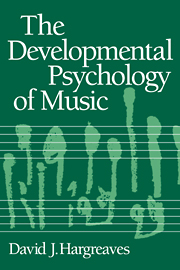Book contents
- Frontmatter
- Contents
- Preface
- 1 The developmental psychology of music
- 2 Children's thinking and musical development
- 3 Musical development in the preschooler
- 4 Musical development in the schoolchild
- 5 Development of responses to music
- 6 Creativity, personality, and musical development
- 7 Social psychology and musical development
- 8 Developmental psychology and music education
- References
- Author Index
- Subject Index
5 - Development of responses to music
Published online by Cambridge University Press: 27 August 2009
- Frontmatter
- Contents
- Preface
- 1 The developmental psychology of music
- 2 Children's thinking and musical development
- 3 Musical development in the preschooler
- 4 Musical development in the schoolchild
- 5 Development of responses to music
- 6 Creativity, personality, and musical development
- 7 Social psychology and musical development
- 8 Developmental psychology and music education
- References
- Author Index
- Subject Index
Summary
Many people hear music every day of their lives. Most households in twentieth-century Western society possess a radio, television, and record- or tape-playing equipment, and music is ever-present in shops, railway stations, cafes, waiting-rooms, and so on. Music, live as well as recorded, is ubiquitous, and it follows that the potential range and diversity of the musical experience of any individual is vast. People do not listen in a vacuum; they choose different types of music to suit different activities and environments, and actively or passively ‘listen’ with varying degrees of attentiveness. In other words, ‘musical response’ covers a very wide range of human experience.
It is hardly surprising, given this diversity, that the study of responses to music is scattered throughout various areas of psychology, music, and education. Konečni (1982), in reviewing the literature, makes what would seem to be the fairly obvious point that psychological explanations should deal with the range of musical experience in its entirety. In other words, we should consider music in all its diverse contemporary forms, and we should take account of all the psychological factors that might affect people's responses to it: ‘… a thorough understanding of aesthetic behavior cannot be achieved without examining how it changes as a function of its immediate social and nonsocial antecedents, concurrent cognitive activity, and resultant emotional states’ (Konečni, 1982, p. 498).
- Type
- Chapter
- Information
- The Developmental Psychology of Music , pp. 105 - 142Publisher: Cambridge University PressPrint publication year: 1986



